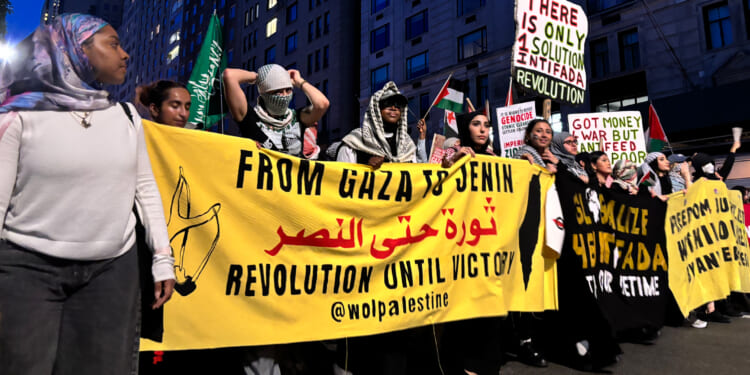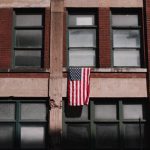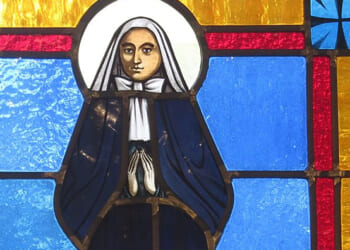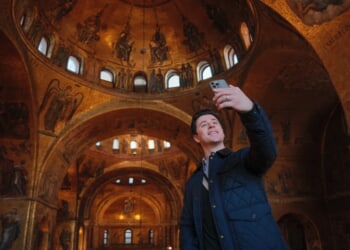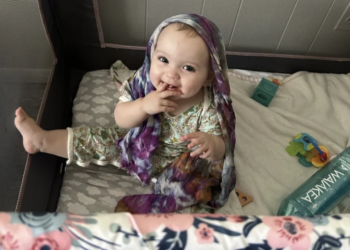Meet Adrian. With round wire-rim glasses, shaggy brown hair, and a beard, he looks like a throwback to the student radicals of the 1960s. His politics are a throwback, too. Standing on a sidewalk in the South Bronx, around the corner from the Mitchel Houses project on Alexander Avenue near East 135th Street, he speaks of war crimes and genocide, of the sins of capitalism and imperialism. He calls on those in the “belly of the beast” need to become seditious and “side with the people of the world” against the United States of America.
It’s a hot Saturday afternoon, and Adrian wears a t-shirt featuring a photo of Joe Biden, above the words “War Criminal.” In one hand he holds a microphone, in the other a stack of flyers for a protest at the Israeli Consulate in New York on October 7. He calls that date the second anniversary of the “Al-Aqsa flood,” (Hamas’s term), when the “Palestinian resistance . . . broke through the apartheid wall and took the fight to their enemies.”
Finally, a reason to check your email.
Sign up for our free newsletter today.
This afternoon, no one is listening to Adrian, but he remains undeterred, railing against Israel’s “genocide” in Gaza and denouncing the “complicity” of the U.S. government. Occasionally, as people walk down the sidewalk, he forces a flyer into their hands.
Adrian is an organizer with Behind Enemy Lines (BEL), a small but growing “anti-imperialist” group with chapters in Chicago and New York and members scattered across the country. This is how he has spent nearly every Saturday for the past ten months. BEL’s highest-profile action to date was a protest at the 2024 Democratic National Convention in Chicago, at which 56 people were arrested—including Adrian—and two police officers injured. BEL co-organized the protest with Samidoun, a “sham charity” that funnels funds to the Popular Front for the Liberation of Palestine (PFLP). Samidoun is banned in Canada and is under U.S. government restriction.
I first contacted BEL in mid-September after seeing its call for nationwide protests on the anniversary of October 7. I told them I was a university student in New York who was interested in joining but took no additional steps to conceal my identity. Days after reaching out, I spoke on the phone with a BEL organizer in Chicago named Michael, who told me the group was hoping to use October 7 to “spark s**t again.” A week later, I was on the phone with Adrian, who said: “For us, the bigger question is always: What are we doing to get people in this country to defect from their loyalty to this thing?”
On October 4, I met Adrian and his comrades in the South Bronx. That afternoon, we spent several hours at the Mitchel Houses project, a series of brick high-rise apartment buildings that opened in 1964, and where residents have long complained about “garbage strewn hallways” and infestations of rats, mice and roaches. There, we put up stickers and posters, handed out flyers, and tried to speak with residents.
One of the posters BEL had planned to distribute read: “Up Against the Wall Motherfucker!” but before heading out, Adrian instructed his comrades to throw it in the trash. When I asked why, he mentioned the death of “a certain right-wing podcaster.”
“It could be construed as a threat,” another member said, adding that the group wanted to avoid a visit from the FBI.
A few days earlier, a boiler explosion at the Mitchel Houses caused a partial building collapse, leaving a 20-story gash in the side of an apartment tower. The BEL activists seized on the explosion to push their message: This is what’s been happening in Gaza every day for two years, and the people responsible for what’s happening there are the same people responsible for what’s happening here.
“The next time Ritchie Torres turns up here,” Adrian said of the Zionist Bronx congressman, “I hope the people run him out.”
Adrian told me that he was born in New York City to a Cuban mother and a father who worked for the United Nations. For a few years, his family had lived in Cuba. They eventually returned to the U.S., where he attended college in Chicago and helped found an anti-capitalist group (I’ve forgotten its name) that now has eight chapters across the country. More recently, after returning to New York, he began organizing with BEL.
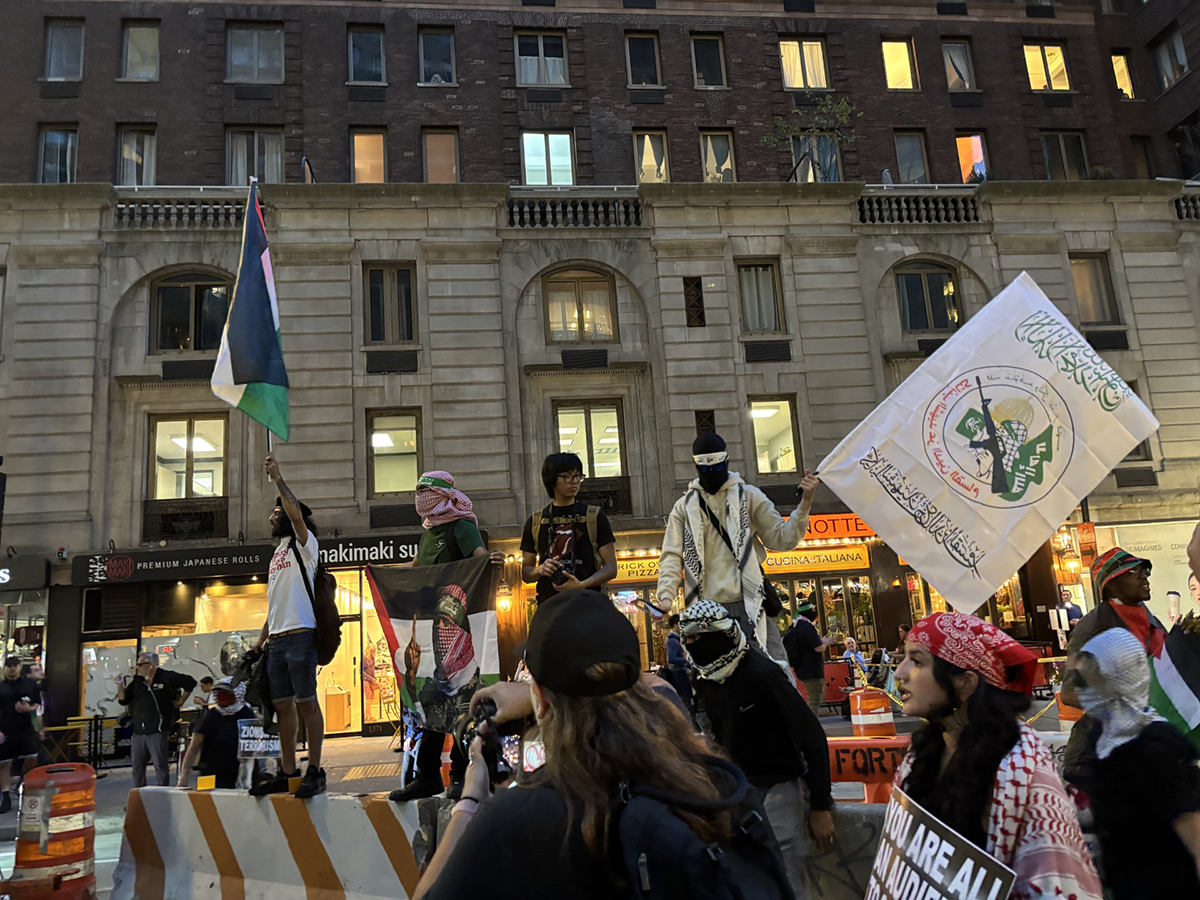
Before leaving, I purchased a copy of Going Against the Tide, the Organization of Communist Revolutionaries’ theoretical journal, which BEL members had been hawking on the sidewalk. I was their lone sale of the day. The slim, 163-page volume retailed for $20, though Adrian had offered to sell me three issues for the price of two.
OCR is a self-styled Maoist vanguard party that bars its members from acknowledging their membership to outsiders without leadership’s approval. On the subway ride back to my hotel, I read a few of the articles. One claimed ICE is composed of “fascist thugs”; the other argued that capitalism is perpetrating a “slow genocide against trans people.”
“You don’t have to be a communist to join Behind Enemy Lines,” Adrian told me at the end of the afternoon. “But I am one.”
On October 7, I returned to the South Bronx to attend the “speak out” that BEL organized near the Mitchel Houses project. Aside from the BEL members themselves, turnout was small. As a speaker accused Israel of turning Gaza into a “dystopian, post-apocalyptic wasteland,” a BEL member approached a man who had stopped to watch.
“Would you like to take the mic and say something about the genocide in Gaza?” the member asked.
“If I take the mic, the only thing I wanna talk about is UFOs,” the man said.
To cap off the speak-out, BEL members splattered red paint, symbolizing blood, on photographs of various U.S. politicians, both Democratic and Republican, and on one of Israeli president Benjamin Netanyahu.
Around 4 p.m., roughly 25 protesters affiliated with BEL, many with keffiyehs or surgical masks covering their faces, arrived at the Israeli Consulate in Manhattan. Instead of gathering at the front of the building as planned, they were forced to protest at the corner of the intersection after the NYPD blocked off the sidewalks. A scuffle soon broke out between demonstrators and police, with two BEL members led away in handcuffs.
For 30 minutes, fiery speeches and pro-Palestinian chants emanated from the crowd. Hundreds of New Yorkers moved down the sidewalks, gawking at the curiosity.
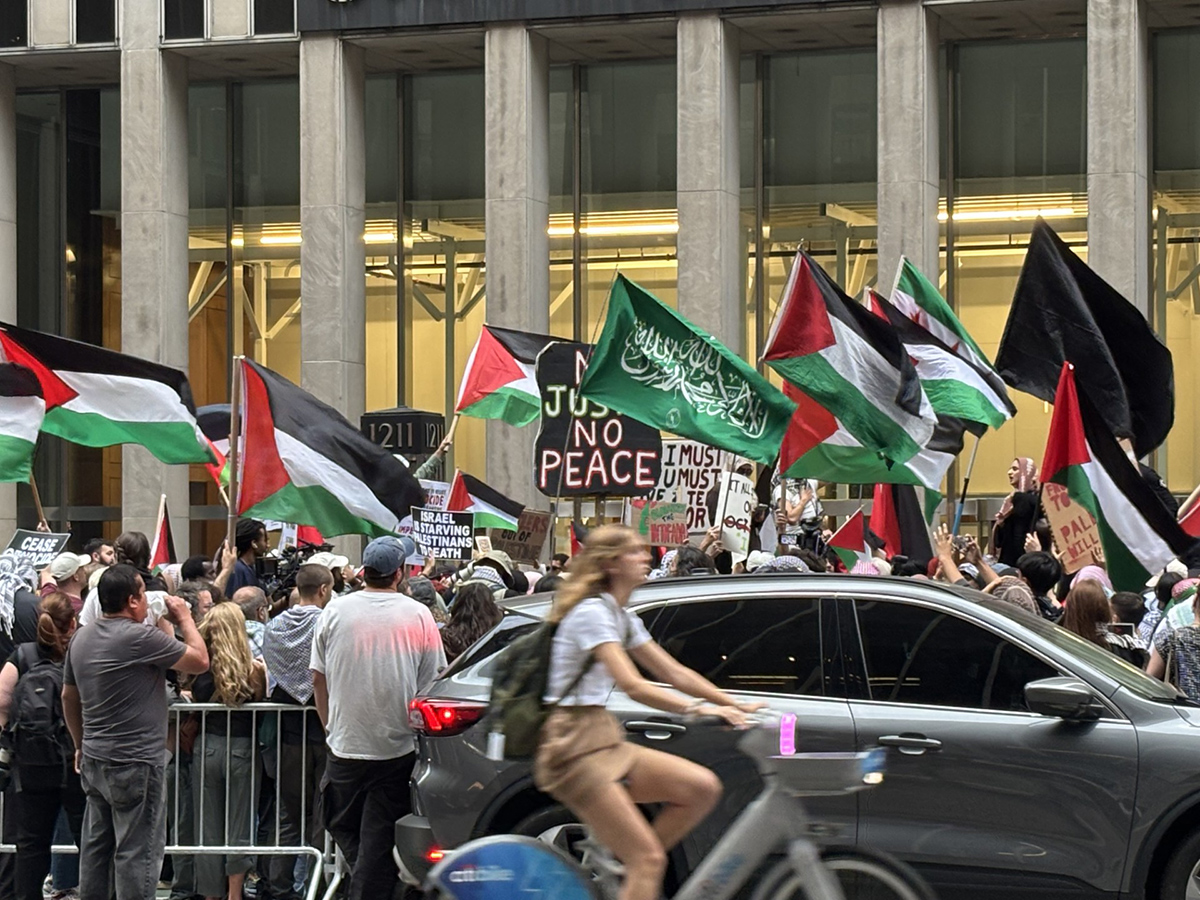
“Free Palestine! Free Palestine!” mimicked one passerby, mocking the chant in a high-pitched voice. “F**k off,” he added in a thick New York accent.
BEL members closed the protest by burning American and Israeli flags, symbolizing their “pledge of allegiance to the people of the world.” Then, it was over: After months of preparation and a public pledge to “[hit] the Israeli Consulate with all we’ve got,” after vowing to “escalate for Gaza” and do “whatever it takes to bring this genocide to an end,” the whole affair lasted roughly 40 minutes.
A few blocks away, about 200 pro-Palestinian protesters converged at the News Corp building in Manhattan. Many appeared to be college students; others were young men with their faces covered, either by keffiyehs or balaclavas. Some were openly hostile to outsiders, seemingly itching for a fight. Directly in front of the News Corp building, from the middle of the crowd of protesters, a Hamas flag waved in the wind.
As the sun began fading from the sky, the protesters pushed past the NYPD barricades and into the streets. They blocked traffic as they marched through Manhattan, holding banners calling for revolution and placards glorifying “martyrs.” They waved flags for Palestine, Hamas, and Hezbollah. They chanted “Globalize the Intifada!” They did not have a permit, but their unsanctioned march received an escort from the NYPD, as frustrated motorists waited out the passing crowd.
Not far from Radio City Music Hall, a middle-aged Jewish woman walked up a cross street and silently held an Israeli flag. Within seconds, she was swarmed by masked men and keffiyeh-clad women.
“You’re a baby killer! A baby killer!” one woman screamed into her face. “You starved our kids! You’re going to feel it! You’re going to feel it! That disgusting nation!” When the police intervened, they seemed to tell the Jewish woman, rather than those harassing her, to leave.
The marchers made their way to Trump Tower, where an Islamic prayer was held in the street. I stopped at a bus shack to sit down. As the protesters walked by, a woman handed me a newspaper, which appeared to be a copy of The New York Times.
As I unfolded the paper, I realized the banner read The New York War Crimes. On the front page was a quote from Habib Qahwaji, a former executive committee member of the Palestine Liberation Organization. On page 11 was an address from Georges Abdallah, a former member of the PFLP, who served four decades in prison for the assassinations of a U.S. military attaché and an Israeli diplomat.
I folded the paper back up as chants of “Globalize the Intifada” echoed through the streets of downtown New York. That’s when I noticed fresh graffiti on the wall of the bus shack. The graffiti read: “DEATH TO THE IDF, DEATH TO AMERIKKKA.”
Photos: Courtesy of the author
Source link

